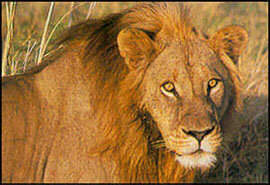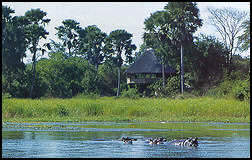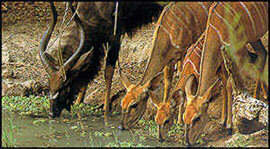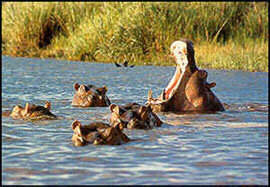 WHERE TO GO? WHERE TO GO? |
 THE PARKS THE PARKS |
 LIWONDE NATIONAL PARK LIWONDE NATIONAL PARK |
The Park is a land of flood plain glass lands, reed swamps and floating meadows, the great Shire river caving a swathe along it’s western boundary. Palm trees, sausage trees and massive baobabs grow in the better-drained areas, which then give way to Mopane woodland. This varied habitat provides something of interest for all lovers of wildlife, and being within easy each of the Southern lake resorts, and less than an hour’s drive from Zomba in the south, lies on the route of most visitors.

The park can be approached by boat, gliding silently through the reed beds to view a watery world of great magnificence. You’ll be aware of an amazing variety of bird calls, a dazzle of colour – jacanas egrets, ibises and kingfishers. The Park contains the only population of Lilian’s lovebird in Malawi, and a great variety of woodland species as well as the aquatic birds. Watch for the hippos, submerged and somnolent, bulbous eyes breaking the surface of the water. Suddenly one of them yawns widely, churning the water as it raise itself from the muddy depths, slowly to subside again.
Elephant come down to drink, with a great display of swaying trunks. Immersing themselves to keep cool, and displacing vast amounts of water, they pay no attention to the approaching boat. As they emerge again, dripping water and mud, their hides gleam dark grey with wetness.
If you are driving to the park, there is a network of roads for easy game viewing. Lush grazing on the plains attracts groups of as many as forty waterbuck, smaller groups of reedbuck and other antelope. A stalking lion may be seen.
Over in the Mopane bush the proud sable, with its majestic sweeping horns, measuring up to 1.5m along the curve, can be seen in large concentrations. Here also live the delicate baboons cascade through the trees in tireless frolic.
Walking is only permitted when accompanied by a game scout, as both lion and leopard are found here. The new eight bed luxury tented MVUU WILDERNESS LODGE has en suite facilities and a separate dinning room/bar/lounge area.
 Kasungu National Park Kasungu National Park |
Kasungu National Park offers general game viewing and contains several sites of archaeological interest. Miombo woodland covers much of the park, interspersed with open, seasonally flooded flats. There are Buffalo, Zebra, several antelope species and warthog, which are prayed on by the occasional lion, leopard and cheetah.
 Nyika National Park Nyika National Park |

The park is approximately 3,200 square. About 900km square has a high plateau of 2,100 metres to 2,600m in altitude. The climate is temperate with cool nights and warm days, frost occurs in June, July and August. The park is open throughout the year but access to roads often becomes impassable to all but four-wheel drive during the height of the rains, from January to April. Zebra, roan, eland, reedbuck, bushbuck, duiker, warthog, hyena, civet, jackal, honey badger, porcupine and leopard are found here. |  Lake Malawi National Park Lake Malawi National Park |
The major attractions in the park are tropical fish, including many colourful cichlid species. The lake is home to over 500 species of fish, most of which are unique to these waters.
 Lengwe National Park Lengwe National Park |

The park is situated 74km south of Blantyre, the last 9km being unsurfaced road. The roads in the park are track of which many are closed in the rainy season December to April. Due to its low altitude the temperatures are high between september and December but the earlier months are preferable for comfort. Visitors may walk in the park accompanied by a game guard. A nature trail near the entrance may be followed unaccompanied. In the park you can see Nyala antelope, at its most northerly range, also buffalo, sable, impala, bushbuck, baboons and monkeys.
 GAME AND FOREST RESERVES GAME AND FOREST RESERVES |
There are a number of game and forest reserves, but these are less development for the visitor. However, should you be prepared to rough it off the beaten track a visit to these will repay the effort.
 VWAZA MARSH GAME RESERVE VWAZA MARSH GAME RESERVE |
In the north is a birdwatcher’s paradise due to its high habitat diversity. The flood plains of the South Rukuru River and scenic Lake Kazuni attract elephant, buffalo and hippo, many species of antelope and predators.
 MAJETE GAME RESERVE MAJETE GAME RESERVE |
On the west bank of the shire river. Contains the magnificent Kapichira falls. Kudu, sable and waterbuck are found in the riverine woodland, as well as elephant, and there is excellent birdwatching in the vicinity of the Falls.
 MWAVI GAME RESERVE MWAVI GAME RESERVE |
In the south, with its many hills, sandstone ridges and rocky gorges, is the home of leopard and various antelope. Birdlife is rich in the evergreen thicket area.
 NKHOTAKOTA GAME RESRVE NKHOTAKOTA GAME RESRVE |
On the spectacular Rift Valley escarpment, comprises woodland and evergreen forest Ares. Here elephants are found, also buffalos, hippos, lions, leopards and hyaenas. Bird life is profile. Sport fishing for lake salmon can be enjoyed in the Bua River.

 MICHIRU MOUNTAIN CONSERVATION area MICHIRU MOUNTAIN CONSERVATION area |
Near Blantyre, and the forest reserves of MULANJE, ZOMBA, DEDZA, NTCHISI, DZALANYAMA AND VIPHYA all have outstanding birdlife and varied and interest flora. Walking along the forest path is delightful and relaxing.
|

